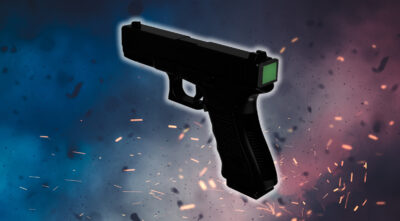Green Light Sights
 Green Light Sights are designed to solve 8 problems associated with top mounted iron or red dot sights.
Green Light Sights are designed to solve 8 problems associated with top mounted iron or red dot sights.
1- Reaction time: Reaction time is faster with Green Light Sights for 2 reasons. First, the operator does not need to spend time finding and aligning the small front and rear sights (especially hard to do while moving), or in the case of red dot sights, finding a red dot that has left the optic field. Second, unlike favoring tunnel vision, which has shown to slow reaction time, Green Light Sights favor peripheral vision, which has shown to speed reaction time.
2- Does not require fine motor control: At the close distances of actual gunfights (~10′), what is important to know is whether a shot taken when aiming at chest/center of mass will hit the vital organs of the chest/thoracic cavity. With traditional handgun sights, it is impossible to know how far out of alignment the sights can be and still make hits in the thoracic cavity. With Green Light Sights, as soon as the optic flashes green, the operator will know that a shot placed at center of mass has a very high likelihood of hitting the thoracic cavity at 10′. The small variations of a shaking hand from stress, injury, exhaustion or being forced to shoot from the weak hand can cause a traditional handgun sight to show as an unaligned presentation. The operator will then have to guess. Is the unaligned presentation so far out of alignment that the shot will miss, perhaps hitting an unintended target or is it close enough to make the shot? The operator must decide to either ‘spray and pray’ or wait for a better alignment, which with both a moving target and a moving operator, may not appear in the 3 seconds the average gunfight outcome is decided in. A gunfight is not the time to be guessing or waiting. Green Light Sights give you a simple yes or no answer. If the optic is green, you can shoot, if not, you will miss.
3- Tunnel vision: With Green Light Sights, both eyes are kept open and the target is looked at, not the sight. Peripheral vision (situational awareness) is maintained.
4- Coordinated movement: Accuracy is what gets shots on target. Getting off the X is what keeps you from getting shot. Tunnel vision has been shown to make movement slower (limb apraxia) and less coordinated. Green Light Sights optimize peripheral vision and thus make movement faster and more coordinated.
5- Depth perception: With Green Light Sights, both eyes are kept open, thus maintaining depth perception.
6- Blurry target: With Green Light Sights, the focus is on the target, where it should be. The fact that the optic is blurry (not in the focal plane) is irrelevant. All the operator needs to see is that the optic has turned green, and they know that any shots fired at center mass at 10′ will make impact the thoracic cavity.
7- Muzzle flip: While muzzle flip will still take place when a handgun is fired, since Green Light Sights are on the rear of the handgun, it is far less effected. Muzzle flip is most pronounced at the end of the barrel (where traditional front sight posts are), not the rear of the handgun (where the optic is placed).
8- Presbyopia: Weak vision can make focusing at close objects (like the front sights of a gun) challenging. By focusing on the target and letting the sight go blurry, Green Light Sights overcome this challenge.
